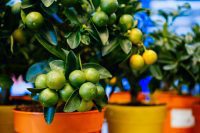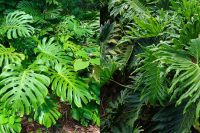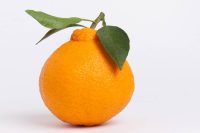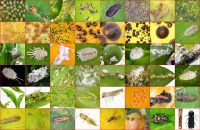Fallen fruit refers to the fruits that have dropped from a tree or plant, either due to natural processes, such as ripening, or external factors like strong winds, animals, or human intervention. While it may seem harmless, leaving fallen fruit on the ground can lead to several potential consequences that can negatively impact the health and aesthetics of a garden, orchard or farm.
Here in Sydney, we have a huge issue with cockatoos pulling citrus off our trees. They take one bite and discard the remaining fruit. Cockatoos have a knack for knowing just when the fruit is about to be harvested, and swooping in a day or two before. Their feeding leaves one giant mess of partially chewed and rotting citrus in our yard which becomes a haven for plant pathogens.
Vectors

Vectors play a crucial role in the spread of plant diseases. Insects, mites, nematodes and even mammals can all be vectors. Essentially, a vector inadvertently picks up a pathogenic plant disease but is unaffected. It then transmits the disease to other plants when it feeds.
Probably the most well-known vector is the mosquito which is capable of transmitting diseases to plants and animals (humans included). When the mosquito feeds, she inserts her mouthparts (proboscis) into the skin, injecting saliva to prevent the blood from clotting. During this process, pathogens within the mosquito can be injected into the skin, passing on parasites and diseases to the host. Only the female mosquito takes a blood meal to produce eggs, male mosquitoes feed on flower nectar and fruit juices.
Fallen fruit that is fresh and disease free can be harvested for human or animal consumption or composted. Diseased or rotten fruit should be discarded.
Disease prevention and control

Fruit that is left to rot attracts vectors and pests which can potentially contaminate soil and plants. It is important for the gardener to be aware of the potential risks associated with leaving fruit on the ground and take appropriate action.
Bacteria
Bacteria are single-celled organisms that come in various shapes and sizes and can be found in diverse environments, from soil to human bodies. Bacteria can be beneficial, such as those involved in nitrogen fixation, fermentation, or digestion, or harmful, causing various diseases and infections. These microscopic organisms reproduce asexually through a process called binary fission and can exchange genetic material through horizontal gene transfer, allowing them to adapt quickly to changing environments.
- Fire blight (Erwinia amylovora): A gram-negative, rod-shaped bacterium that affects plants in the Rosaceae family, including apple, pear, and ornamental plants such as hawthorn and cotoneaster. First described by TJ Burrill in 1878, fire blight has since spread to Europe, Asia, and the Middle East. Fire blight is a highly contagious disease that can lead to significant economic losses for commercial fruit growers. It spreads through various means, such as rain, wind, insects, and contaminated gardening tools. The bacterium enters plants through natural openings, like stomata, or through wounds caused by pruning, frost, or hail damage.
- Soft rot (Erwinia, Pectobacterium, and Dickeya): A common bacterial infection caused by several species of bacteria. These pathogenic bacteria feed on pectin, cellulose, and hemicellulose in plant tissues, resulting in the softening and decay of infected plant parts. A wide range of fruits, vegetables, and ornamental plants are susceptible to soft rot. It can cause significant damage to crops and result in substantial economic losses for growers. The bacteria responsible for soft rot can enter plants through wounds, insect feeding sites, or natural openings such as stomata or lenticels.
- Bacterial canker (Pseudomonas syringae): One of the most common plant pathogens that is found in soil, water, and on plant surfaces. P. syringae infects a wide range of plant species, including beans, tomatoes, stone fruits, and cereals. There are currently 49 pathovars (strains) that can infect one or multiple host species. Common symptoms include leaf spots, blights, cankers, galls, and fruit spots.
Viruses
Viruses are infectious agents composed of DNA or RNA, wrapped in a protein envelope. They are unable to replicate in the cells of a host organism by using cellular machinery. Viral infections can be transmitted by insect vectors that are attracted to fallen fruit. For example, mosquitoes, aphids, whiteflies, and leafhoppers can be attracted to fallen fruit, and inadvertently transmit viruses to healthy fruit or plants in the garden or orchard.
- Mosaic virus: A group of plant viruses that infect a wide range of plant species. Infected plants develop a mottled or mosaic-like appearance of chlorotic (yellow) tissue on the leaves, stunted growth, reduced plant vigour and decreased crop yields. The virus is transmitted via vectors, especially whitefly, leafhopper and aphids.
- Plum pox virus (PPV): A serious viral disease that affects plums, peaches, and apricot. PPV can be spread by aphids, grafting infected plant material, and in some cases, through root grafts between trees.
- Citrus tristeza virus (CTV): As the name would suggest, the citrus tristeza virus affects citrus trees. CTV is transmitted by aphids which feed on the sap of infected trees and then spread it to healthy trees when they feed. Trees on the ground can be a potential source of food for aphids.
Fungi
Pathogenic fungi produce spores spread through the air, potentially infecting nearby plants and leading to plant diseases such as brown rot and powdery mildew. Fungal infections weaken plants, reduce crop yield, and even cause plant death in severe cases.
- Brown rot (Monilinia fructigena): A bacterial disease of stone fruits such as peaches, plums, cherries, and apricots, Monilinia species can cause fruit decay, blossom blight, and twig cankers. The spores can spread through the air, rain splash, or by insects, leading to infections in nearby plants.
- Apple scab (Venturia inaequalis): A fungal disease of apples and other plants within the rose family. Apple scab a reduction in fruit quality and yield, and eventually weaken the tree so it is at risk of opportunistic infections. Windfall fruit provides a suitable habitat for V. inaequalis to produce fungal spores that can infect healthy trees when spores are carried via wind or rain.
Water moulds
Water moulds are a group of aquatic microorganisms which resemble fungi but are distinct in their genetic makeup and cell wall composition, and are known for causing diseases in plants and aquatic organisms.
- Pythium (Pythium spp): A genus of parasitic oomycetes (water moulds) made up of 200 species worldwide. These organisms are soil-borne and can infect a wide range of plants, causing diseases such as damping-off, root rot, and seedling blight. Pythium reproduces asexually or sexually. Chlamydospores are thick-walled, spherical resting structures which are formed under conditions of stress, such as nutrient limitation or adverse environmental conditions, and can remain dormant in soil or decaying plant matter for extended periods of time. When plant material starts to decay, it releases nutrients into the soil, creating an environment that is favourable for Pythium chlamydospore germination. The chlamydospores can then germinate and infect nearby plants, causing disease.
Pests

- Codling moth (Cydia pomonella): A common pest of apples, pears, and other fruit-bearing trees in the family Rosaceae. Codling moth larvae cause damage to fruit when they tunnel into the fruit to feed on the seeds and surrounding flesh resulting in significant crop loss.
- Carpophilus beetle (Carpophilus marginellus): Also known as dried fruit beetle or sap beetle, the carpophilus beetle is a common beetle with a worldwide distribution. The adult beetle lays its eggs on rotting or damaged fruit on the floor, larvae hatch and pupate in the ground. The adult beetle burrows into and feeds on stone fruit on the tree, or apples and citrus that have fallen onto the ground. The carpophilus beetle is a potential transmitter of disease, especially brown rot.
- Fruit fly (Drosophila melanogaster): Fruit flies are small black insects that you may have noticed swarming around your fruit bowl if it contains overly ripe fruit. When a fruit falls from a tree and starts to decay, it releases an odour that attracts fruit flies. These flies are particularly drawn to fruits high in sugar, such as apples, grapes, bananas, and peaches. Fruit flies lay their eggs on the surface of the fallen fruit, and when the larvae hatch, they feed on the decaying organic matter. When fruit flies land on infected plant materials or fruits and then move to healthy plants, they may carry fungal spores or bacteria that could potentially infect healthy plants, however, they are at a lower vector risk than other insects such as whiteflies and aphids.
- Houseflies (Musca domestica): One of the most annoying insects on the planet, houseflies are the scourge of summer. They feed on a wide range of food, including feces and rotting animals. Houseflies are not considered vectors to other plants, however, they are associated with spreading pathogens that cause human and animal diseases due to their habit of feeding on a wide range of organic matter, including decaying food, feces, and garbage.
- Wasps: The sweet smell of fermenting sugars in overripe fruit can attract wasps, especially yellowjackets and hornets which feed on the sugars in the fruit. The risk of wasps transmitting diseases is relatively low, but not impossible as they can indirectly spread pathogens from one plant to the surface of another. Wasps can also set up nests in the garden, which are unwelcome, especially in high-traffic areas which potentially exposes household members to the risk of a sting.
- Rodents: Rodents are opportunistic animals and will feed on a wide variety of food sources. They are highly adaptable and will consume whatever is readily available in their environment. Their diet can include seeds, grains, fruits, vegetables, insects, small invertebrates, bird eggs, and even carrion. Rodents can carry and transmit a number of diseases to humans and other animals. In addition to the risk of disease, rodents can attract snakes, which are a primary food source.
Aesthetics
Let’s face it, rotting fruit in the home garden or orchard looks messy. If you are like me and have planted fruit trees in a lawned area, mowing can be more of a challenge when you’re mowing over dropped fruit. Rotting fruit doesn’t look nice or smell nice in the garden or orchard.
Potential slipping hazard
As fruit starts to decompose, it can take on a slimy texture that runs the risk of an accident if somebody slips on it. This not only impacts you and your visitors but potentially members of the public if the tree is dropping fruit onto public areas such as footpaths. Should an accident occur, you could be held liable for medical expenses.
Pet hazard
Most fruits commonly grown in the home garden are safe for pets. Although the seeds of fruits such as apples and pears are labelled toxic due to a cyanide-producing compound called amygdalin, a pet would have to consume a considerable amount to become sick. There is a risk of gastrointestinal blockage if the pet consumes an apple or pear core, or a larger seed such as an apricot, mango or avocado, which can become lodged in the gastrointestinal tract.
Conclusion
- Fallen fruit should be picked up daily and consumed or discarded to prevent pests, wild animals, injury from slipping and accidental ingestion of cores or large seeds by pets. A rake can help if there is a lot of fruit on the ground.
- While you are picking up fruit, check fruit trees for sign of disease and damage and take action as required.
- Fruit left to decay can attract diseases and wild animals including rodents and snakes.
- Netting fruit trees can reduce fruit wastage by protecting the tree from birds. Select a netting with a small aperture of 5 mm to prevent birds from becoming entangled and keep insects out.
- If netting isn’t an option, it may be possible to pick the fruit just before it ripens to prevent loss from birds. Apples, pears, bananas, avocados, mangoes, peaches, kiwis and plums are all able to be picked once they have reached their mature size, but before ripening has occurred. This will reduce the loss of fruit to birds or winds.
Julia is a writer and landscape consultant from Wollongong with a love of horticulture. She had been an avid gardener for over 30 years, collects rare variegated plants and is a home orchardist. Julia is passionate about learning and sharing her knowledge of plant propagation and plant toxicology. Whether it’s giving advice on landscape projects or sharing tips on growing, Julia enjoys helping people make their gardens flourish.




